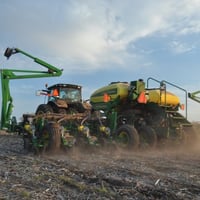The USDA released its sixth Crop Progress report this week.
Rain Causing Growing Concern for U.S. Crops

Reuters recently reported that “in the United States, a top food exporter, intense heat has gripped parts of the east coast, while excessive rains in the key Midwest growing region and forecasts for more wet weather have raised fears of floods.”
“In the Midwest, the focus is shifting from heat to too much rain, which could result in flooding on corn and soybean producing areas, especially in the Upper Midwest,’ [meteorologist Chris] Hyde said.”
The Associated Press reported that “in the Midwest, where South Dakota, Iowa, and Minnesota meet, floodwaters continued to be on the rise. In northwest Iowa, 13 rivers flooded the area, according to Eric Tigges of Clay County emergency management. Entire neighborhoods — and at least one entire town — were evacuated, and the town of Spencer imposed a curfew Sunday for the second night in a row after flooding that surpassed the record set in 1953.
“National Weather Service meteorologist Donna Dubberke said parts of northern Nebraska, southeastern South Dakota, southern Minnesota, and northwest Iowa received eight times the typical average rainfall. And more heavy rain was expected this week,” The Associated Press reported.
Excess moisture threatening harvest progress and crop yields
In Minnesota, the Mankato Free Press reported that “the number of farmers and the number of counties dealing with excess moisture is only growing. Waseca already had the third wettest spring in 110 years of record-keeping when the stats were recently updated at the University of Minnesota’s Southern Research and Outreach Center in Waseca.”
“We’ve really been stuck in a rainy pattern,’ said Tom Hoverstad, a scientist at the Research and Outreach Center. There are a lot of areas that were planted, drowned out/flooded out, drained, were replanted and now have drowned out again.”
“The problem in those low-lying spots is impossible to miss — sickly, dead or never-planted crops,” Hoverstad reported. “… When all of the impacts are combined, farmers could see their annual incomes getting soaked. By the time you’re done, it’s very easy to lose [10%–15%] of the yield potential,” Hoverstad said.
And in Wisconsin, WBAY’s Samantha Cavalli has reported that “northeast Wisconsin farmers are asking for the rain to stop, as it’s hurting their chances of planting and harvesting their crops.”
“Mark Petersen of Petersen Dairy Farm says he hasn’t been able to consistently get out onto his fields because of the weather,” Cavalli reported. “Many of the crops he has planted are under too much moisture, while crops waiting to get put into the ground may not make it in time. He says he’s heard multiple farmers complain about this year’s season as they remain at the mercy of round after round of rain.”
“We’ve still got some dry hay to harvest yet and that’s a nightmare,’ says Petersen.” “We can’t do it because of the weather forecast. It should’ve been harvested optimum the last week of May so we’re getting a month late and it’s getting overly ripe and feed quality is not worth a darn at this point.”
More rain in the forecast
AccuWeather’s Renee Duff reported that “drenching showers and, in some instances, damaging thunderstorms have been a nearly daily occurrence recently amid hot and steamy air.
“Fronts slicing into the heat and humidity often give thunderstorms an extra boost of wind energy, increasing the likelihood of downed trees, power outages and even isolated tornadoes,” Duff reported. “AccuWeather experts say another front is likely across the Midwest and Northeast, setting the stage for more widespread severe thunderstorm risks.”
EDITOR’S TAKE:
Weather is always a huge risk factor for farmers/ranchers in any growing season. It appears that 2024 may be one of those years where the danger is even greater than normal. Time is running short to produce a “normal” crop for many of the areas reported in this article. Depending on how widespread the impact will determine how much or how little prices may be affected. We will continue to monitor the effect of weather for 2024 crops as well as the impact on the incomes of farmers/ranchers across the country. Thus far, the impact can be minimized if the rain subsides and crops are planted in the near future. Depending on the answer to these concerns will determine the impact on potential truck sales later this year.







.jpg?height=200&name=Soybean%20-%20field%20w%20red%20barn%20%26%20silo%20(3).jpg)